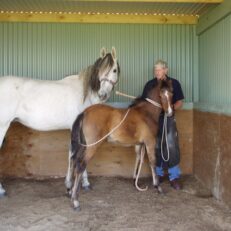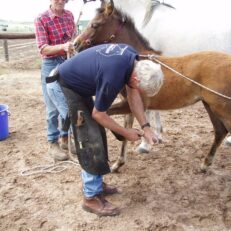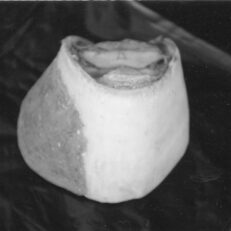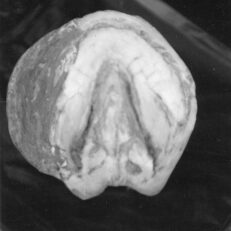With the new season’s foals growing fast, now is an opportune time to get our minds around the subject of training the young horse to be shod.
As the breeding and competition standards have become higher over the years, so too has the need to handle our young horses from an earlier age become more important. There is plenty of evidence to show us that most bent leg problems in foals can be corrected by careful attention of the farrier from as early as three weeks after birth; at this age the foals are very easy to hold (close to mum of course) and should then be trimmed regularly to establish a pattern. Because these foals are handled regularly from an early age, shoeing is generally not a problem.
But what happens to the foal which has perfect legs from birth? The tendency is often to do nothing with this group, until they are weaned at about six months of age and are much stronger and then need to be halter broken, taught to lead, tie up (using a breeching rope) then have the legs handled and hooves trimmed. To avoid this problem, these foals should have been handled continually from three weeks old.
I do not condone the use of twitches or leg ropes, especially ear twitches, instead just take a little more time, allow him to learn to balance on three legs, which will give him confidence. They respond so quickly to kindness. Teaching the foal good habits for shoeing is important. Make sure you reward for good behaviour and not for poor behaviour.
If a horse is broken in or handled in a logical sequence using the ‘be firm but be fair’ rule, lifting his legs to trim them is never a big deal. The earlier you start a hoof maintenance programme the easier it is also to correct potential leg action problems.
Trim only the excess hoof wall length, and only flaky sole and excess bar to achieve a balanced hoof. There should be no flares in the foals hoof wall when correct. Regular monthly maintenance is essential.
Bent legs in foals are an agonising problem for all concerned. A percentage of bent legs in foals is hereditary and as a result it is my belief that unless previous foals from the blood line have a history of growing out of the problem or have been successfully straightened by either veterinarian or farrier intervention, it is not wise to continue breeding from that line.
History has shown that if we start off a young horse with inherent lower-leg problems, it creates a never ending risk of unsoundness, which usually occurs when the horse is at the peak of its performance.
They may be kept sound for a short career by good farrier or veterinary attention but is this really fair on the horse? Overweight mares often produce foals with bent legs, usually due to the lack of space in the mare for the foal to develop. However, once on the ground, these nearly always straighten naturally.
Despite our efforts, care should be taken to regularly inspect the foal’s lower leg hoof alignment, say weekly, for the first two or three months of its life, as things can still go wrong.
As the foal’s hoof begins to harden and the ground dries out, the foal’s body weight increases at the same time and wear on the tiny hoof begins. Often, just as this tiny hoof capsule begins to grow any length, one side breaks away. This creates an uneven hoof which unless corrected quickly, will start to turn the foal’s lower leg either inwards or outwards.
Correction may be simply a matter of trimming the hoof wall back to level again. Viewed from its front, the rule is that if the foal is pointing his toe in, trim the inside edge. If his toe is pointing out, trim the outside edge; if he is standing too upright, trim the heels, or if he is standing down on his heels, trim the toe.
There is also another likely scenario. If upon inspection you find his toes pointing in but you have no hoof wall to remove inside, the foal must be fitted with an extension to the outside of the hoof. An extended shoe on such an immature hoof will be very hard to keep on (a hoof this young is not ready to be nailed). Also, a nailed on shoe is going to cause restriction to the rapidly developing and expanding young hoof,
Synthetic hoof materials such as BondNFlex can be used to achieve these corrective measures with a great degree of success. Bonding quickly to the hoof wall without the need for shoes or nails, these synthetic materials can be used to extend the hoof wall in any direction and do not impede the natural development of the hoof and the extension can be reduced in size as the leg straightens. Once bonded, the synthetic material will grow down with the hoof wall and can be trimmed and rasped the same as a normal hoof wall.
Stud owners and breeders have now realised the importance of correcting bent legs in their foals as early as possible. Prices at yearling sales reflect this as well as extending the competitive life of their valuable stock.




